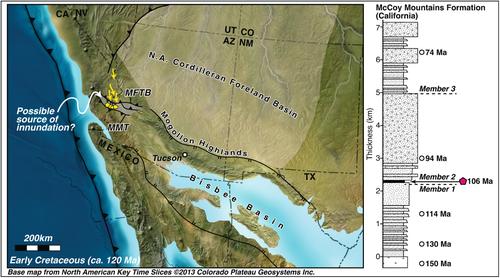当前位置:
X-MOL 学术
›
Basin Res.
›
论文详情
Our official English website, www.x-mol.net, welcomes your
feedback! (Note: you will need to create a separate account there.)
The real McCoy: A record of deep‐water basin deposition in southwestern North America during the Cretaceous
Basin Research ( IF 2.8 ) Pub Date : 2024-10-04 , DOI: 10.1111/bre.12902 Emilia A. Caylor, Barbara Carrapa, Peter G. DeCelles, George E. Gehrels
Basin Research ( IF 2.8 ) Pub Date : 2024-10-04 , DOI: 10.1111/bre.12902 Emilia A. Caylor, Barbara Carrapa, Peter G. DeCelles, George E. Gehrels

|
The McCoy Mountains Formation (McMF) in southern California–Arizona preserves an anomalously thick record of sedimentation during the Mesozoic at a critical time when western North America experienced contrasting tectonic events related to intracontinental rifting along the Mexican Border rift system and consolidation of the North American Cordilleran system. The spaciotemporal interactions among these events and the development of the McCoy basin challenge our understanding of the evolution of the southern extent of North America. At its type locality in the McCoy Mountains, the McMF consists of ~ 7 km of low‐grade metasedimentary rocks, originally interpreted as meandering fluvial to alluvial‐fan deposits. Uncertainty in the initial timing of sedimentation in the McCoy basin has resulted in multiple tectonic models. We measured ~ 7160 m of detailed stratigraphy and present new sedimentological and detrital zircon results showing that the McCoy basin was occupied by deep‐water turbidite systems. These systems deposited an upward‐coarsening succession of fine‐ to coarse‐grained detritus during the Cretaceous (ca. 137–70 Ma). Provenance data indicate that the McCoy basin received sediment from Proterozoic basement rocks and metamorphosed Palaeozoic to early Mesozoic sedimentary units. These source rocks are equivalent to the stratigraphy found in the Grand Canyon and Colorado Plateau regions and were likely shed from the southward‐advancing Maria fold‐thrust belt and possibly the southern Sevier belt in southern Nevada and California. These results, combined with subsidence curves typical of foreland basins, favour deposition within a subaqueous flexural foreland basin system. The presence of a Cretaceous foreland basin this far southwest challenges previously proposed models and suggests that the contractional tectonic regime associated with the North American Cordillera extended into the southwestern most United States during the Early–Late Cretaceous.
中文翻译:

真正的麦考伊:白垩纪北美西南部深水盆地沉积的记录
位于南加利福尼亚-亚利桑那州的麦考伊山脉组 (McMF) 在中生代保留了异常厚的沉积记录,当时北美西部经历了与墨西哥边境裂谷系统沿线的大陆内裂谷和北美科迪勒拉系统整合相关的对比构造事件。这些事件之间的时空相互作用和 McCoy 盆地的发展挑战了我们对北美南部范围演变的理解。在 McCoy 山脉的类型位置,McMF 由 ~ 7 公里的低品位变质沉积岩组成,最初被解释为蜿蜒的河流到冲积扇沉积物。McCoy 盆地沉积初始时间的不确定性导致了多个构造模型。我们测量了 ~ 7160 m 的详细地层,并提出了新的沉积学和碎屑锆石结果,表明 McCoy 盆地被深水浊积岩系统占据。这些系统在白垩纪(约 137-70 马)沉积了从细粒到粗粒的碎屑的向上粗化序列。物源数据表明,McCoy 盆地接收了来自元古代基岩的沉积物,并变质为古生代到早期中生代沉积单元。这些烃源岩相当于在大峡谷和科罗拉多高原地区发现的地层,可能是从南进的 Maria 褶皱逆冲带以及内华达州南部和加利福尼亚州南部的 Sevier 带脱落的。这些结果,结合前陆盆地典型的沉降曲线,有利于在水下弯曲前陆盆地系统内沉积。 如此遥远的西南端白垩纪前陆盆地的存在挑战了以前提出的模型,并表明与北美科迪勒拉山脉相关的收缩构造机制在早白垩纪至晚白垩世期间延伸到美国最西南部。
更新日期:2024-10-04
中文翻译:

真正的麦考伊:白垩纪北美西南部深水盆地沉积的记录
位于南加利福尼亚-亚利桑那州的麦考伊山脉组 (McMF) 在中生代保留了异常厚的沉积记录,当时北美西部经历了与墨西哥边境裂谷系统沿线的大陆内裂谷和北美科迪勒拉系统整合相关的对比构造事件。这些事件之间的时空相互作用和 McCoy 盆地的发展挑战了我们对北美南部范围演变的理解。在 McCoy 山脉的类型位置,McMF 由 ~ 7 公里的低品位变质沉积岩组成,最初被解释为蜿蜒的河流到冲积扇沉积物。McCoy 盆地沉积初始时间的不确定性导致了多个构造模型。我们测量了 ~ 7160 m 的详细地层,并提出了新的沉积学和碎屑锆石结果,表明 McCoy 盆地被深水浊积岩系统占据。这些系统在白垩纪(约 137-70 马)沉积了从细粒到粗粒的碎屑的向上粗化序列。物源数据表明,McCoy 盆地接收了来自元古代基岩的沉积物,并变质为古生代到早期中生代沉积单元。这些烃源岩相当于在大峡谷和科罗拉多高原地区发现的地层,可能是从南进的 Maria 褶皱逆冲带以及内华达州南部和加利福尼亚州南部的 Sevier 带脱落的。这些结果,结合前陆盆地典型的沉降曲线,有利于在水下弯曲前陆盆地系统内沉积。 如此遥远的西南端白垩纪前陆盆地的存在挑战了以前提出的模型,并表明与北美科迪勒拉山脉相关的收缩构造机制在早白垩纪至晚白垩世期间延伸到美国最西南部。




















































 京公网安备 11010802027423号
京公网安备 11010802027423号